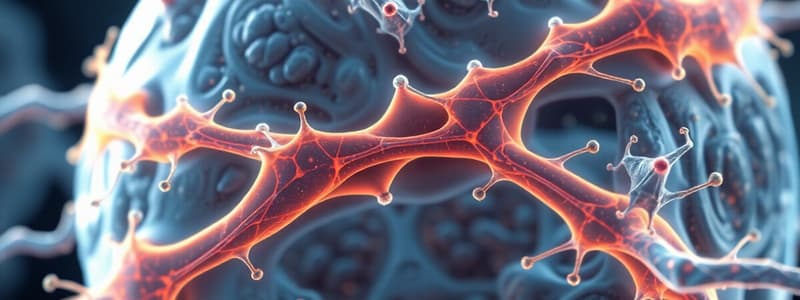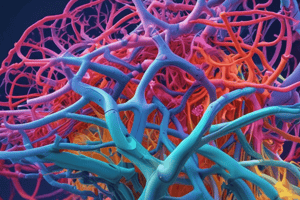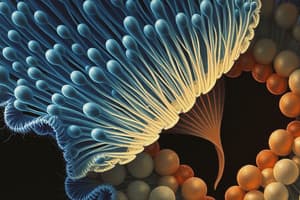Podcast
Questions and Answers
What is the main function of communicating junctions?
What is the main function of communicating junctions?
- To prevent the movement of proteins between cells
- To provide structural support to cells
- To facilitate nutrient absorption
- To permit movement of ions or signaling molecules between cells (correct)
What type of proteins form a seal in tight junctions?
What type of proteins form a seal in tight junctions?
- Claudins and occludins (correct)
- Selectins and desmogleins
- Cadherins and integrins
- Catenins and adherens
Which junction type has a Ca2+-dependent mechanism?
Which junction type has a Ca2+-dependent mechanism?
- Tight junctions
- Zonula adherentes (correct)
- Desmosomes
- Gap junctions
Which is a characteristic feature of desmosomes?
Which is a characteristic feature of desmosomes?
What structure is formed by the connection of two connexons?
What structure is formed by the connection of two connexons?
What is the composition of the plaques in desmosomes?
What is the composition of the plaques in desmosomes?
What dimensions are gap junctions' intercellular channels typically characterized by?
What dimensions are gap junctions' intercellular channels typically characterized by?
Which type of junction provides a mechanical connection between cells through intermediate filaments?
Which type of junction provides a mechanical connection between cells through intermediate filaments?
What are the main structural components of intermediate filaments?
What are the main structural components of intermediate filaments?
Which type of intermediate filament is primarily found in epithelial cells?
Which type of intermediate filament is primarily found in epithelial cells?
What is the role of occluding junctions in cell biology?
What is the role of occluding junctions in cell biology?
What type of junctions are macula adherens?
What type of junctions are macula adherens?
Which statement is true regarding the individual subunits of intermediate filaments?
Which statement is true regarding the individual subunits of intermediate filaments?
Which type of junction functions to maintain cell-to-cell or cell-to-basal lamina adherence?
Which type of junction functions to maintain cell-to-cell or cell-to-basal lamina adherence?
Which intermediate filament is associated with glial cells?
Which intermediate filament is associated with glial cells?
What type of structure do fascia junctions create between cells?
What type of structure do fascia junctions create between cells?
Flashcards
Intermediate Filaments
Intermediate Filaments
Rope-like protein structures composed of tetramers, tightly bundled into helical arrays, providing structural support to cells. Different types exist, including keratins, desmin, vimentin, and more.
Keratins
Keratins
A type of intermediate filament found in epithelial cells (skin, lining of organs).
Desmin
Desmin
Intermediate filament found in muscle cells, providing stability to muscle tissue.
Intercellular Junctions
Intercellular Junctions
Signup and view all the flashcards
Zonula (Belt-like) Junctions
Zonula (Belt-like) Junctions
Signup and view all the flashcards
Anchoring Junctions
Anchoring Junctions
Signup and view all the flashcards
Occluding Junctions
Occluding Junctions
Signup and view all the flashcards
Fascia (Sheet-like) Junctions
Fascia (Sheet-like) Junctions
Signup and view all the flashcards
Macula (Disc-like) Junctions
Macula (Disc-like) Junctions
Signup and view all the flashcards
Tight Junctions
Tight Junctions
Signup and view all the flashcards
Zonula adherens
Zonula adherens
Signup and view all the flashcards
Claudins and Occludins
Claudins and Occludins
Signup and view all the flashcards
Cadherins
Cadherins
Signup and view all the flashcards
Desmosomes
Desmosomes
Signup and view all the flashcards
Gap Junctions
Gap Junctions
Signup and view all the flashcards
Intermediate Filaments
Intermediate Filaments
Signup and view all the flashcards
Connexins
Connexins
Signup and view all the flashcards
Connexons
Connexons
Signup and view all the flashcards
Study Notes
Intermediate Filaments
- Constructed from tetramers of rod-like proteins
- Tightly bundled into helical arrays
- Individual subunits vary based on filament type
- Types include keratins, desmin, vimentin, glial fibrillary acidic protein, neurofilaments, and nuclear lamins
Intercellular Junctions
- Specialized areas where cells connect
- Classified morphologically into three types:
- Zonula (belt-like) junctions: Encircle cells completely
- Fascia (sheet-like) junctions: Form broad contact areas
- Macula (disc-like) junctions: Like spot welds on cell surfaces
- Functionally classified into types:
- Occluding junctions: Form impermeable barriers
- Anchoring junctions: Provide mechanical stability
- Communicating junctions: Allow ion/molecule transfer
Cellular Junctions
- Tight junctions (Zonula occludens):
- Encircle cells
- Formed by fusion of outer membrane layers
- Seal prevents paracellular transport
- Utilize claudins, occludins, and cadherins
- Adherens junctions (Zonula adherens):
- Located below tight junctions
- Bind cells through cadherins
- Link to actin filaments
- Desmosomes (Macula adherens):
- Spot welds connecting cells
- Have plaques that bind intermediate filaments
- Important for tissues under stress
- Gap junctions (Nexus):
- Specialized channels between cells
- Made of connexons for ion/small molecule exchange
Studying That Suits You
Use AI to generate personalized quizzes and flashcards to suit your learning preferences.




